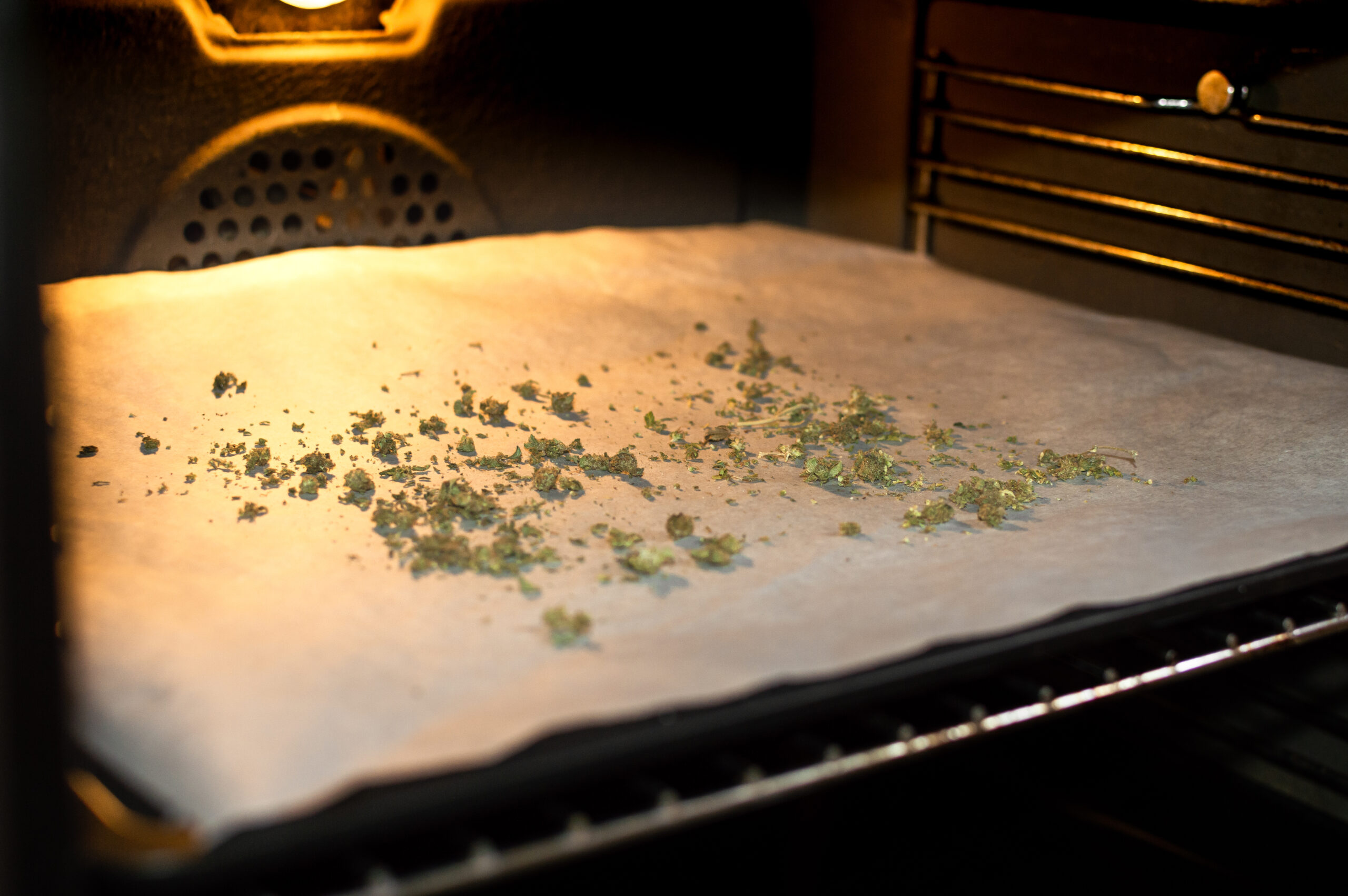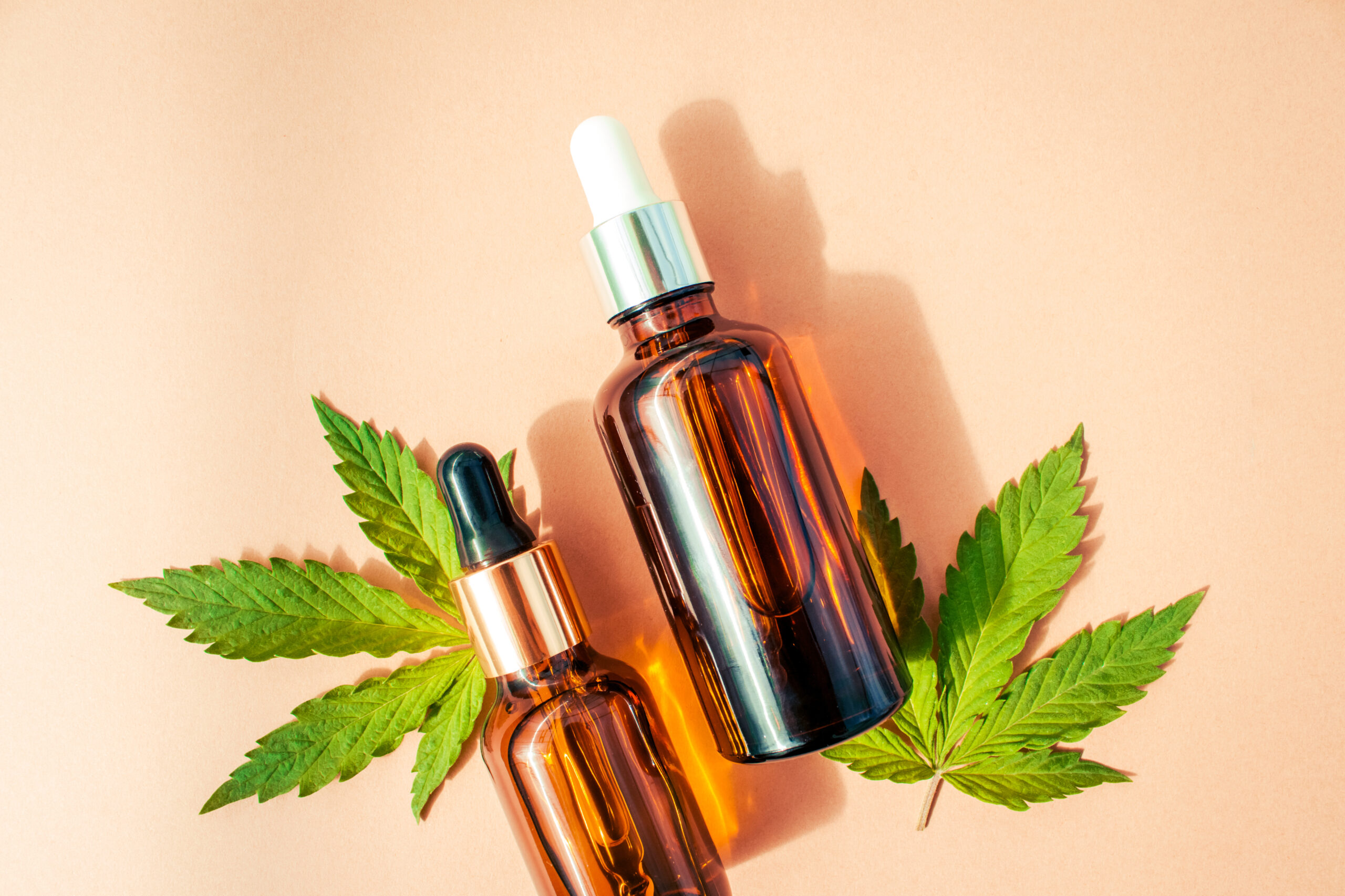Potent, discreet, and shelf-stable, cannabis tinctures are the unsung heroes of the cannabis world, providing precise doses of cannabinoids whenever you need them. And while you’ll find a wide selection of expertly made tinctures at most dispensaries, what you might not know is that they’re easy enough to make at home.
If you’ve ever wondered how to make a cannabis tincture, you’re in the right place. In this curated guide, we’ll share step-by-step methods for oil-and alcohol-based infusions, potency math, and more.
Making Weed Tinctures at a Glance
Creating cannabis tinctures at home is a simple process that combines decarboxylated flower with a carrier like high-proof alcohol, MCT oil, or glycerin. Once combined, the mixture is left to infuse over time, then strained and stored in a dropper bottle for easy, accurate dosing. Whether you’re looking for a long-lasting alcohol tincture or a gentle, alcohol-free option, homemade tinctures offer a customizable, shelf-stable way to experience the effects of cannabis with precision and discretion.
How to Make Potent Weed Tincture: Tools & Ingredients
Trust us: It isn’t difficult to make a weed tincture at home, but you’ll want to make sure you have all your tools and ingredients on hand first. Here’s where to start:
Equipment List
- Scale: To measure a precise amount of cannabis flower for decarboxylation
- Baking sheet & parchment paper: To hold the cannabis flower during decarboxylation
- Oven thermometer: To be sure you’re decarboxylating at the optimal temperature
- Mason jar(s): To safely store the tincture while it’s maturing.
- Fine mesh/cheesecloth: To strain all the plant matter out of the finished tincture
- Droppered glass bottle: The best way to dispense cannabis tincture, as the graduated dropper allows precise dosing
Pro tip: Whenever possible, opt for glass over plastic when storing and maturing tinctures. Why? Glass is non-reactive and won’t leach chemicals into the tincture, while alcohol-based tinctures can degrade the plastic over time
Ingredients List
- 1oz decarboxylated cannabis flower
- 2.5 cups high-proof grain alcohol (where legal) or MCT/olive oil
- Sunflower lecithin (optional): This natural product can help emulsify tinctures, especially when mixing oil-based and water-based products. It helps create a stable, uniform mixture and can also increase bioavailability
How to Choose the Right Flower for You
Choosing the right strain of cannabis for your tincture depends on the type of experience you’re looking for. In general, strains are grouped into three broad categories: sativa, indica, and hybrid.
- Sativa strains are often described as uplifting and energizing, making them a popular choice for daytime use or for promoting creativity, focus, or a light mood boost.
- Indica strains, on the other hand, are typically associated with deeper relaxation, physical comfort, and restfulness, which may be ideal for evening use or winding down.
- Hybrid strains offer a blend of both effects, as they are bred from indica and sativa genetics. Depending on the dominant traits, a hybrid may lean more toward calming or energizing, or it may provide a more balanced effect that suits a wide range of needs.
When selecting a flower for your tincture, consider the intended outcome—whether you’re seeking relaxation, clarity, sleep support, or general relief—and choose a strain that aligns with that goal. If you’re unsure, a well-balanced hybrid is often a versatile place to start, especially for first-time tincture makers.
Step-by-Step: How to Decarboxylate Cannabis
Once you’ve chosen a strain to infuse, you’re going to need to decarboxylate (or “decarb”) your cannabis, which is the process of applying gentle heat to convert the inactive THCA cannabinoid in cannabis flower into its active form of THC.

The simplest way to do this is by using an oven or toaster oven.
- Start by preheating your oven anywhere from 220°F to 240°F. If you have an oven-safe thermometer, now’s the time to use it, as the internal thermostats in ovens typically aren’t very accurate.
- Measure and roughly grind your cannabis. We recommend enough to fill half of an eight-ounce Mason jar (roughly half an ounce).
- Cover a cookie sheet with parchment paper.
- Place your ground cannabis flower on the cookie sheet and place it in the heated oven.
- Let bake for 30 minutes to fully decarboxylate the cannabis. Along the way, check for doneness cues; the flower should be lightly toasted and dry—not dark brown or scorched.
- Take out the flower and let it cool before proceeding.
Easy, right? For the most part, decarbing cannabis isn’t hard, but there are a couple of common mistakes to avoid. If the flower is unevenly ground, you may end up with hot and cool spots, in which the flower is overdone or incompletely decarbed.
And keep a close eye on the temperature. If the flower overheats, you’ll lose the precious terpenes that contribute to signature aromas and subtle medical benefits.
Want to go even deeper into the process of decarboxylation? Start with the Mission Decarbing Guide.
Step-by-Step: Alcohol-Based THC Tincture How-To (Green Dragon)
As the classic form of cannabis tincture, a “green dragon tincture” is shelf-stable, potent, and easy to absorb. If you’re learning how to make a cannabis tincture with grain alcohol or vodka, the process is admirably simple. Before you get started, just bear in mind two key elements:
- Decide on a Base: Thanks to its high proof and purity, neutral grain (often sold as Everclear) is the best alcohol for a THC tincture. Does it really matter? While using vodka isn’t a deal-breaker, a higher alcohol content will allow for the maximum possible cannabinoid and terpene extraction.
- Decide on a Ratio: As a starting point, we suggest using 1oz (28g) of flower to 2.5cups (590mL) of alcohol. If you’re aiming for an ultra-potent tincture, consider upping the ratio to your taste.
Steps
- Fill a glass Mason jar ¼–½ way with decarbed flower and cover with the alcohol of your choice.
- Install the lid and store the jar in a dark, cool space for 2 – 3 weeks or longer.
- Give the jar a gentle shake daily.
- When you’re done, strain with a fine mesh, discard the flower, and store for long-term use.
That’s it! You’ve now made an alcohol-based tincture.
For an even quicker option, consider the “Fast-Wash” method. Sometimes known as the cold/quick soak method, this results in a greener profile as it specifically targets terpenes. The process is simple: Just shorten the soaking time from three weeks to three minutes before straining. However, resist the urge to squeeze the flower when done, as this will add more chlorophyll, not more cannabinoids and terpenes.
Safety tip: Never heat high-proof alcohol on a stovetop or in an oven; it’s extremely flammable.
Step-by-Step: Oil-Based THC Tincture (MCT or Olive Oil)
For making cannabis tinctures that are non-alcoholic, the simplest method employs a standard Crock-Pot or slow cooker using MCT oil—short for “medium-chain triglyceride,” a nutritional product typically made from coconut oil—or another kind of carrier oil, like olive oil.

Which oil should you choose? MCT is great for its neutral flavor (and it absorbs particularly well sublingually), If you’ll be cooking with the finished tincture, olive oil is superior for cooking and integration into your cooking routine.
Steps
- Take your 1oz of decarbed flower and add it to 2.5 cups of neutral oil or MCT, and place them in a Crock-Pot or slow cooker with the lid slightly vented.
- Set the heat to “low” or approximately 190°F and allow the mixture to simmer for at least 2 hours, up to a total of 6 hours. During this time, check the temperature and try not to let it exceed 200°F.
- Once the time has elapsed, strain the oil through a cheesecloth (again, don’t press down on the solids too hard) and decant into a jar for storage.
Alternatively, you can cook the flower and oil mixture on a stovetop—if you’re using gas, a “flame tamer” or diffuser will help here. However, be aware that a long, low-temperature process tends to produce superior results. For even more precise results, you can use a sous vide machine, an appliance that subjects bagged and sealed products to very specific temperatures. Incidentally, the in-bag feature is great for odor control and temperature accuracy.
Step-by-Step: Glycerin Tincture (Alcohol-Free & Sweet)
One popular choice of carrier liquid is food-grade glycerin. A clear liquid typically made from soybean, coconut, or palm oils, glycerin is odorless and has a mild, sweet taste with a syrup-like consistency.
Compared with alcohol- or oil-based tinctures, glycerin is a gentle solvent. That means glycerin tinctures should be made via a slow, room-temperature or warm maceration process. While it has a shorter shelf life than alcohol-based tincture, it’s great for making edibles and for those with sensitive palates.
If you want to learn how to make a cannabis tincture with glycerin, here are the essential steps:
- Collect your equipment: This includes decarbed flower, a clean Mason jar, and a strainer.
- Decide on a Ratio: Because glycerin is a weaker solvent than alcohol, we suggest starting with a ratio of 14g of flower for every cup (240mL) of glycerin. If you’re aiming for an ultra-potent tincture, consider upping the ratio to your taste.
Steps
- Fill a glass Mason jar ¼–½ way with decarbed flower and add the measured glycerin.
- Install the lid and store the jar in a dark, cool space for 2 – 3 weeks or longer.
- Give the jar a gentle shake daily.
- When you’re done, strain with a fine mesh, discard the flower, and store for long-term use.
Potency Math: How to Measure THC in a Cannabis Tincture
Wondering how to measure THC in tincture? While you can purchase a home testing kit, you can also figure it out using just a bit of math. First, if you measured the weight of the flower you used and know its cannabinoid content from the label, you can calculate the dosage.
Let’s say you used an ounce (28g) of cannabis at 20% THC and 600 ml of base liquid (alcohol, oil, or glycerine).
- To find the milligrams of THC contained in your total THC tincture recipe, multiply the weight of the cannabis by its THC content. In this example: 28g x 20% = 5.6 g of THC. Multiply this by 1,000 to get milligrams: 5.6g of THC = 5,600 mg THC.
- Due to plant matter absorption and filtering losses, you can generally count on capturing 70 – 80% of the usable THC through this process. For a rough estimate of total THC, multiply your total by .75 (or 75%): 5,600 x .75 = 4,200 total mg THC per batch.
- Finally, because you used 600 mL of carrier liquid, divide the total milligrams of THC (4,200 mg) by 600 to get the total THC per 1ml dose: 4,200/600 = 7mg.
Since a standard dropper contains 1mL, this means that a full dropper contains roughly 7 mg of THC. Need to know how much THC per bottle? A standard one-ounce bottle contains roughly 30 mL, or 210mg THC. A two-ounce bottle contains roughly 60 mL, or 420mg THC.
How to Take a Tincture (Sublingual vs Swallowed)
Need to know the best way to take tincture, and how many drops of THC tincture to take? Here’s how to take cannabis tincture sublingually, as well as in a more standard edible-style regimen:
- Sublingual Dosing: Dispense your measured dose directly from the dropper under your tongue, then wait 30 – 60 seconds before swallowing the tincture. Thanks to the network of blood vessels found there, the cannabinoids will be absorbed relatively rapidly—typically within 15 – 45 minutes.
- Swallowed Dosing: You can add a measured dose of tincture to your favorite food or beverage, or swallow it directly. In this case, the onset will be slower, more like a standard edible—typically between 30 and 90 minutes, up to as long as 2 hours. The effects will also be longer-lasting than with sublingual application, lasting between 4 and 6 hours, in some cases even longer. If you mix your tincture with foods or beverages, use products that are cool or are room temperature, since high heat can degrade the cannabinoids in a tincture.
Whichever method you use, remember to start low and go slow. Especially when you’re first working with cannabis tinctures, take 2 – 5mg to begin with and then wait at least 90 minutes to assess the effects.
Learn more about cannabis tinctures in the Mission Guide to Tinctures.
Cannabis Tinctures: Storage, Shelf Life & Safety
A well-made cannabis tincture should last for many months as long as you take some basic precautions. As with all cannabis products, light and heat are the enemies of freshness and potency. Store your tincture in a dark glass container in a cool, dark place or, better yet, your refrigerator. You can even freeze cannabis tinctures, though repeatedly thawing oil-based tinctures can be time-consuming.
Here’s guidance for specific tincture types:
- Alcohol-based: Store at room temperature, ideally in dark glass; typical shelf life is 12–24 months.
- Oil-based: Best stored in a refrigerator; typical shelf life is 6–12 months; be watchful for any rancid odor, which indicates the tincture has expired.
- Glycerin: Best stored in a refrigerator; typical shelf life is 3–6 months.
If you’re making your own THC tincture, be sure to label each bottle with its strength and the date it was produced. Store tinctures in child-resistant bottles for those who shouldn’t have access to THC. And if you reheat an alcohol-based tincture, never do so directly on the stove or around flames.
Start Your Next Tincture with Mission
Though learning how to make a cannabis tincture can be quick and easy, it does require patience and care. After the crucial step of decarboxylating your cannabis, you can make an alcohol-based “green dragon” tincture or an oil- or glycerin-based infusion instead. Whichever you try, remember: Start low and go slow when first using them.
Ready to start exploring the world of cannabis tinctures? Begin the journey at the nearest Mission dispensary, where you can find a variety of frosty flower for your next DIY tincture or ready-made tinctures backed by our personalized, expert guidance.
How to Make Potent Weed Tincture: FAQs
Do I have to decarb cannabis to make a tincture?
Yes. In order for the THCA in raw cannabis to become active, it has to undergo the heat-induced chemical reaction known as decarboxylation to become the psychoactive cannabinoid THC.
How long does a THC tincture last?
Do THC tinctures expire? THC tinctures have an extremely long shelf life, up to two years if stored carefully. To maintain optimal potency, we recommend you keep yours in a dark, cool place away from direct sunlight.
Can cannabis tinctures be made without alcohol?
Yes. If you’re interested in learning how to make a weed tincture without alcohol, follow our guidance on oil- or glycerin-based tincture recipes. When made carefully, they combine potency, versatility, and a long shelf life.
What’s the best alcohol to make a THC tincture?
If it’s legal and available where you live, the best alcohol for a THC tincture is a neutral high-proof grain alcohol. This makes for an exceptionally long-lasting tincture, with some having a shelf life of up to two years.
Can you use distillate to make a cannabis tincture?
Yes. If you want to learn how to make a cannabis tincture with distillate, simply combine the distillate with the carrier oil or alcohol base of your choice. Calculating the potency per mL is also simple: Just divide the mg of THC in the distillate by the total mL of the base.

